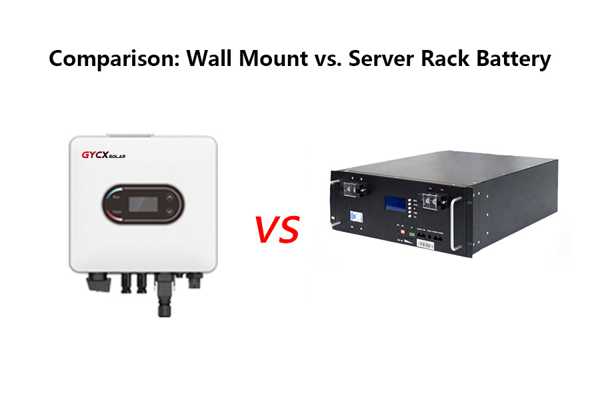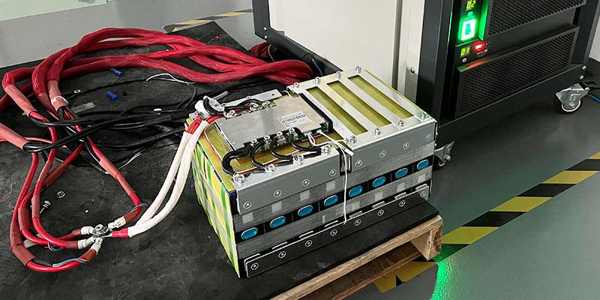Was ist ein Rack -Akku?
Bei der Erforschung von Solarenergiespeichern oder robusten Backup -Stromversorgungssystemen, Sie treffen häufig auf den Begriff "Rack -Akku"" oder "Rack-montierte Batterie." Was genau ist das, Und warum ist es eine beliebte Wahl für professionelle und hochkomplizierte Installationen? Lassen Sie uns diese leistungsstarke und skalierbare Energiespeicherlösung entmystifizieren.
Eine Rack-Batterie ist ein Lithium-Ionen-Batteriemodul, am häufigsten mit dem sicheren und langlebigen LFP verwendet (Lithium -Eisenphosphat) Chemie, das wird zu einer standardisierten 19-Zoll-Breite gebaut. Dieses spezifische Design ermöglicht es, sicher zu installieren oder "ausgestattet zu werden" in einen Standardausrüstungschrank oder einen standardmäßigen Rack. Diese Module sind die Bausteine einer hohen Dichte, organisiert, und leicht skalierbares Energiespeichersystem, den Kern vieler moderner Bess bilden (Batterie-Energiespeichersystem) Lösungen.

Bei Gycx Solar, Wir entwerfen häufig Systeme mit Verwendung Lithiumbatterien mit Rackmontage Weil sie unglaubliche Flexibilität und Leistungsdichte bieten. Sie ermöglichen es uns, eine perfekt große Energielösung für unsere Kunden zu bauen, von großen Häusern bis hin zu Handelsunternehmen. Lassen Sie uns untersuchen, wie sie funktionieren und wie sie mit anderen Optionen verglichen werden.
Das ist besser?
Dies ist eine der häufigsten Fragen bei der Auswahl eines Heim- oder Business -Batteriesystems. Du hast die schlanke, Geräteartige Wandmontageeinheiten und die industrielleren Einheiten, Modulare Server -Rack -Batterien. Welches ist das "besser" Wahl für Sie?
Weder ist universell "besser"; Die beste Wahl hängt vollständig von Ihren spezifischen Bedürfnissen ab, insbesondere Skalierbarkeit und Ästhetik. Wandmontage Batterien sind oft "besser" Für diejenigen, die eine schlanke Priorität priorisieren, All-in-One-Design und haben Standard-Energiespeicheranforderungen. Server -Rack -Batterien sind "besser" Für diejenigen, die eine größere benötigen, hoch skalierbar, oder mehr maßgeschneidertes System, Bieten größerer Flexibilität und oft einen besseren Wert pro kWh bei höheren Kapazitäten.

Tauchen tiefer: Wählen Sie Ihren Batterieformfaktor aus
Lassen Sie uns die Vor- und Nachteile eines jeden brechen, um Ihnen bei der Entscheidung zu helfen:
Wandmontage Batteriesysteme (Z.B., Tesla Powerwall, ENPHASE IQ -Batterie):
- Am besten für: Hausbesitzer, die eine bestimmte wollen, Gemeinsame Kapazität (Z.B., 10-14 kWh), schätzen eine saubere, Gerätsähnliche Ästhetik, und bevorzugen eine Einzelmarke, integrierte Lösung.
- Vorteile:
- Ästhetik: Entwickelt, um in einer Garage oder einer Nutzungsraumwand gut auszusehen.
- Einfachheit: Oft ein All-in-One-Paket mit einem integrierten Akku, BMS, und manchmal seinen eigenen Wechselrichter.
- Markenökosystem: Kann einen nahtlosen Betrieb bieten, wenn Sie bereits andere Produkte aus derselben Marke verwenden.
- Nachteile:
- Weniger skalierbar: Während Sie weitere Einheiten hinzufügen können, es ist oft in groß, Inkremente festgelegt (Z.B., ein weiteres volles Hinzufügen 13.5 KWH -Einheit).
- Proprietär: Kann Sie manchmal in das Hardware- und Software -Ökosystem eines bestimmten Herstellers einsperrten.
Server -Rack -Batteriesysteme (Z.B., Modulare LFP -Batterien von Marken wie Growatt, Pylontech, EG4):
- Am besten für: Benutzer mit hoher Energiebedarf, Diejenigen, die zukünftige Expansion erwarten, Anwendungen außerhalb des Gitters, oder jeder, der maximale Flexibilität und Kontrolle über ihre Systemkomponenten hat.
- Vorteile:
- Hoch skalierbar: Sie können leicht kleinere Inkrementmodule hinzufügen (oft ~ 5kwh) Um genau Ihren Bedürfnissen zu entsprechen und im Laufe der Zeit zu erweitern. Bau einer 20 kWh, 30kWh, oder ein größeres System ist unkompliziert.
- Flexibilität: Viele Rackbatterien verwenden offene Kommunikationsprotokolle, Ermöglichen.
- Kosteneffektiv im Maßstab: Fördert oft niedrigere Kosten pro kWh, wenn größere Batteriebanken bauen.
- Hohe Dichte: Verpackt viel Energie in einen Kompaktrack -Fußabdruck.
- Nachteile:
- Ästhetik/Raum: Erfordert eine engagierte (aber kompakt) Bodenschrank oder Rack, Das sieht ein industrieller aus.
GYCX Solar Story: "Wir führen Kunden täglich durch diese Wahl. Für einen Eigentümer in Singapur mit begrenztem Platz und dem Wunsch nach einem sauberen Look, Eine einzelne Wandmontage war perfekt. Für einen Geschäftsinhaber, der 40 kWh Speicher benötigt, Ein Schrank mit acht unserer stapelbaren Rackbatterien war weitaus skalierbar und kostengünstiger."
Müssen Lithiumbatterien flach montiert werden??
Eine häufige Frage, die sich aus alten Batterieregeln ergibt, ist, ob moderne Lithiumbatterien strenge Anforderungen an die Installationsorientierung haben. Müssen sie immer flach gelegt werden??
NEIN, Moderne versiegelte Lithium-Ionen-Batterien müssen nicht flach montiert werden. Dank ihrer internen Konstruktion, das enthält keinen frei fließenden Flüssigelektrolyten, Sie können in fast jeder Orientierung installiert werden - flach (horizontal), auf ihrer Seite, oder aufrecht (vertikal). Diese Designfreiheit ermöglicht genau das, was die Schaffung von vielseitigen Formfaktoren wie elegantem Erstellen ermöglicht Wandmontage Einheiten und kompakt Rack -Batterien.

Tauchen tiefer: Freiheit vom flüssigen Elektrolyten
Das "muss aufrecht sein" Regel ist ein Überbleibsel von traditionellen überfluteten Blei-Säure-Batterien, die flüssige Schwefelsäure enthalten, die beim Kippen verschüttet werden würde. Moderne Lithiumbatterien, vor allem die LFP1. Typ in unserem verwendet Lithiumbatterien mit Rackmontage, sind grundsätzlich unterschiedlich:
- Durch Design versiegelt: Die Zellen im Inneren sind vollständig versiegelt. Der Elektrolyt ist entweder eine gelähnliche Substanz oder wird vollständig in ein Trennmaterial zwischen den festen Elektroden absorbiert.
- Solide innere Struktur: Die internen Komponenten sind sicher festgelegt und sind nicht von ihrer Ausrichtung im Verhältnis zur Schwerkraft betroffen.
- Ermöglichen Sie moderne Formfaktoren: Diese Flexibilität ermöglicht es den Herstellern,…
- Wandmontage Batterien: Vertikal installiert, um Platz zu sparen.
- Rack -Batterien: Horizontal installiert (schob in das Gestell) um eine hohe Dichte zu erreichen.
Während sie position-agnostisch sind, Sie sollten immer das Installationshandbuch des Herstellers konsultieren. In bestimmten Designs, Es kann ein geben bevorzugt Orientierung zur Optimierung des Luftstroms über Kühlflossen, aber funktional, Sie arbeiten sicher in jeder Position. Diese Vielseitigkeit ermöglicht es uns bei GYCX Solar, unglaublich saubere und platzeffiziente Systeme zu entwerfen, die den einzigartigen Räumen unserer Kunden entsprechen.
Wo ist der beste Ort, um Lithiumbatterien zu halten?
Sie haben Ihr Batteriesystem ausgewählt, Aber wo genau sollte es installiert werden? Der Standort ist genauso wichtig wie die Batterie selbst, um die Sicherheit zu gewährleisten, Leistung, und eine lange Lebensdauer.
Der beste Ort, um Lithiumbatterien zu halten, ist in einem Cool, trocken, und gut belüfteter Ort, der vor direktem Sonnenlicht und physischer Schädigung geschützt ist. Für ein Haus- oder Geschäftsenergiespeichersystem, Dies bedeutet oft eine Garage, ein dedizierter Versorgungsraum, oder ein Innenschrank. Ein professionelles Gehäuse, wie a Batterieregal oder Schrank, Bietet die ideale sichere und organisierte Umgebung.

Tauchen tiefer: Erstellen Sie die perfekte Umgebung für Ihre Batterie
Hier ist eine Checkliste für den idealen Standort der Batteriespeicherung:
- Cool: Wärme ist der Hauptfeind der Batterie -Langlebigkeit. In einem heißen und feuchten Klima wie von Singapur, Es ist wichtig, dass die Installation von Batterien an Stellen, die Wärme fangen, wie nicht belüftete Schuppen oder Gebiete, die einer direkten Nachmittagssonne ausgesetzt sind. Die ideale Umgebungstemperatur beträgt typischerweise etwa 20-25 ° C. (68-77° F).
- Trocken: Halten Sie Batterien von potenziellen Feuchtigkeits- oder Überschwemmungsquellen fern, um ihre elektronischen Komponenten zu schützen (Wie das BMS) und Terminals aus Korrosion und Beschädigung.
- Belüftet: Während LFP -Batterien während des normalen Betriebs kein brennbares Gas produzieren, Sie erzeugen etwas Wärme. Eine gute Belüftung oder der Luftstrom ist für das thermische Management unerlässlich, damit diese Wärme sich löst, die Zellen kühl halten und ein langes Leben sicherstellen. Aus diesem Grund sind unsere Batterieregale und Schränke entwickelt, um den Luftstrom zu erleichtern.
- Sicher und geschützt: Der Standort sollte das Batteriesystem vor versehentlich physischen Auswirkungen schützen, Manipulationen, oder mit anderen Gegenständen überfüllt sein. Es sollte auch von brennbaren Material.
- Zugänglich (Für Service): Sie müssen zwar keine regelmäßige Wartung an versiegelten Lithiumbatterien durchführen, Das System sollte für die erste Installation und jeden potenziellen zukünftigen Service durch einen qualifizierten Techniker zugänglich sein.
Ein engagiertes Rack -Batterie Der Kabinett ist so konzipiert, dass er all diese Kriterien erfüllt, Bereitstellung eines sicheren, organisiert, und belüftetes Haus für Ihr Energiespeichersystem.
Was ruiniert eine Lithiumbatterie?
Um Ihre erheblichen Investitionen in ein Lithium -Batterie -System optimal zu nutzen, Es ist wichtig zu wissen, was dazu führen kann, dass es vorzeitig scheitert. Was sind die üblichen Schuldigen, die eine Lithiumbatterie ruinieren können??
Die wichtigsten Dinge, die eine Lithiumbatterie ruinieren, sind Exposition gegenüber übermäßiger Hitze, unsachgemäßes Laden (Speziell Überladung oder Verwendung eines inkompatiblen Ladegeräts), zulassen, dass es in einem bleibt voll entlassener Zustand lange Zeit, und natürlich, physischer Schaden Als würde man durchstechen oder zerquetscht werden. Glücklicherweise, ein hochwertiger Bess (Batterie-Energiespeichersystem) mit einem raffinierten BMS (Batteriemanagementsystem) ist entwickelt, um die Batterie vor den meisten dieser elektrischen Fehlermodi automatisch zu schützen.

Tauchen tiefer: Schutz Ihrer Batterieinvestition
So wie moderne Systeme, wie das Lithiumbatterien mit Rackmontage Aus GYCX Solar, sind vor diesen gemeinsamen Mörder geschützt:
- Übermäßige Hitze: Wie erwähnt, Wärme beschleunigt den chemischen Abbau.
- Lösung: Ordnungsgemäße Installation in einem Cool, belüftete Lage. Das BMS überwacht auch die Temperatur und wird das System drosselt oder schaltet, wenn es zu heiß wird, Verhinderung katastrophaler Versagen.
- Unsachgemäßes Laden: Das Überladen einer Lithiumbatterie ist äußerst gefährlich und schädlich.
- Lösung: Eine Qualitäts -Bess umfasst ein BMS und einen kompatiblen Ladung Controller (oft Teil eines Hybridwechselrichters) das arbeitet zusammen. Sie verwenden einen präzisen Ladealgorithmus und stoppen automatisch das Laden, wenn der Akku voll ist. Dies macht das Überladen eines Nicht-Aussagen in einem professionell installierten System.
- Tiefentladung auf Null: Eine Batterie hinterlassen bei 0% kann irreversible Schäden verursachen.
- Lösung: Das BMS ist mit einem niedrigen Spannungsschnitt programmiert. Es wird die Batterie automatisch von Ihren Lasten trennen, während es noch ein kleiner gibt, sichere Menge an Energie übrig, Verhinderung einer beschädigten tiefen Entladung.
- Physischer Schaden: Durch die Durchwertung einer Lithium-Ionen-Zelle kann ein Kurzschluss und ein Feuer führen.
- Lösung: Deshalb sind robuste Gehäuse unerlässlich. Unser Rack -Batterie Module sind in robusten Metallgehäusen untergebracht, die dann in einem Schutzschrank installiert werden, Schutz vor zufälligen Auswirkungen.
GYCX Solar Story: "Wir betonen immer, dass eine" Akku "nur ein Teil des" Systems "ist. Das System - das BMS, der Wechselrichter, das Rack, Die ordnungsgemäße Installation - ist der Batterie und macht ihn zu einem sicheren, langlebiger Vermögenswert. Das vollständig, Engineered Lösung ist das, was wir anbieten."
Das Verstehen, was eine Rack-Batterie ist und wie sie mit anderen Formfaktoren wie an Wand montierten Einheiten verglichen werden, ist der Schlüssel zur Auswahl der richtigen Energiespeicherlösung. Rack -Batterien bieten beispiellose Skalierbarkeit und Flexibilität, Aufbau auf sichere und lang anhaltende LFP-Lithiumtechnologie. Indem Sie wissen, wie Sie Ihr Batteriesystem richtig aufbewahren und sich um sie kümmern können, Sie können sicherstellen, dass Sie Jahrzehnte zuverlässig erhalten, saubere Energie.
Wenn Sie Fragen zu unseren professionellen Batterielösungen für Rack-Rack haben oder herausfinden möchten, welcher Systemtyp für Ihr Zuhause oder Ihr Geschäft am besten geeignet ist, Das GYCX Solar Team ist hier, um eine Expertenanleitung zu erhalten. Kontaktieren Sie uns heute für eine Konsultation!
Wenn Sie das Konzept von LFP verstehen. Dies hilft Ihnen, das Produkt auszuwählen, das Ihren Anforderungen von unserem Unternehmen am besten entspricht. ↩
